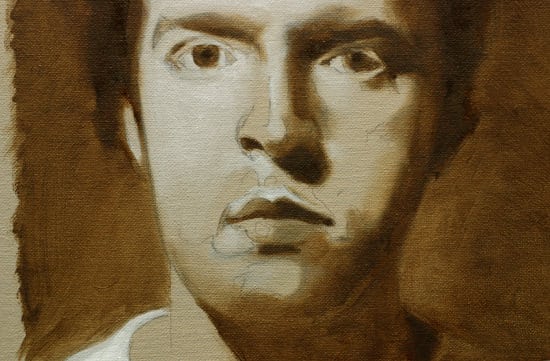
“When you come back to your painting you’ll notice how the oil has become translucent overnight and won’t have the same coverage that you first thought.”
How to paint a portrait series. This is part 3 of a 5 part series of tutorials for beginners making the transition from drawing to oil painting.
Here is a quick review of what we have covered so far if you’d like to join in…
Part 1 – Establishing the drawing, including the shadow line.
This can be done in pencil or charcoal (that you can fix with fixative) try to keep the drawing lines angular to start with.
Try to establish the basic shapes if you could only use a straight line, then add the contours as the drawing progresses. A classic beginner mistake when drawing a portrait is an over exaggeration of the curves in the face. Everything gets ’rounded off’ and the portrait can have a cartoon like quality. Because we have a strong visual memory system that tells us ‘faces are round’ this can subconsciously affect your drawing.
We the started to scrub in the underpainting layer. To a beginner, this stage is often skipped, deemed to be unimportant, but a good foundation is key to success with portraits.
We then have our 3 part tonal underpainting which allows you, and your eye, to become more in-tune with the image, and become aware to the tones.
Part 2 – Developing the tones, adding lights.
We then worked over the top of the initial underpainting still just with the raw umber to strengthen the tones and get a better feeling of form. These layers are all painted thinly.
The medium for this stage being a simple mix of 1 part linseed oil to 4 parts mineral spirits (artist turpentine or odourless mineral spirits) this establishes the ‘fat over lean’ rule. With each progressive layer being slightly fatter – with more oil content.
We also added some roughed in lights with a faster drying white.
This is to help us judge the tones for the next stage so when we paint them on they don’t look to ‘out’ when we add the lights.
The Allure of highlights
I forgot to emphasize at the end of part 2 that the roughed in lights are the light tonal mass and not the highlights.
The highlights and the very darkest parts of the painting should be the last brushstrokes to be done, but they try and draw you in! It’s hard to resist putting them on at the early stage.
And even if you’ve read the warning, it’s amazing how, when you get engrossed in the painting, your hand will be drawn to that lightest white.
This can seem counterintuitive if you are coming to the painting from drawing as we often erase out the lightest areas, or work on this area that attract our attention. The white highlights on the eye have a particular allure.
When the painting is finished these will be seen by the viewer to be painted with the most skill, however, a single dot of white can be painted by anyone, but resisting adding them takes the practice of an artist.
A note about grey
One of the students following this series let me know about Gambiln Torrit grey competition (Thanks Mario!) Every spring, the paint manufacture collect all of the residue paint pigment that have been collected by the air filtration system and recycle them into “Gamblin Torrit Grey”. You can learn more about the Torrit Grey painting competition from Gamblin website.
“Pigment dust should not go into the earth, water or landfill, but into paint,”
Robert Gamblin.
For our grey, we are going to mix a neutral using the raw umber and Ivory black.
Part 3 – First Painting & mixing a new medium

We now create a new medium for the next layer of the painting. Different artists vary the richness of the medium depending on their own personal preference but the next mix is a very useful one.
- 3 parts mineral spirit to 1 part linseed oil
You can use the pipette to measure out amounts, or if I’m mixing a larger amount I’ll use kitchen measurement spoons.
Pro tip: If you are doing a lot of painting it can be worth premixing a larger amount of each medium in resealable jars, label them up and then you can simply decant the medium each stage of the painting.
Mixing our black
We are now going to mix a neutral black for developing this monotone study. You can still create some lovely studies just using the raw umber and white, it is a warmer finish than the black, but you will still learn the importance of contrast in your paintings.

To mix the neutral, we use 3/4 ivory black to 1/4 raw umber. This helps take the blue out of the black (black has a blue base, this is why you can mix lovely muted greens with black)
Ivory black
Ivory black is a slow drying pigment, by mixing in 1/4 of the raw umber (which is quick drying) it will match nicely with the Titanium White (slower drying) and at this stage of the painting the longer ‘open time’ we have with the paints the better. Ivory black also has a lovely richness when painted thinly which will help out in the later stages of the portrait.
This way you will have time to work through your painting and blend and fuse edges that you need to. This is why we started with the raw umber, it dries overnight and has a cooler undertone when working with portraits.
Materials
- Winsor & Newton artist quality Ivory black
- Micheal Harding artist quality Raw Umber
- Old Holland artist quality Titanium White
- Winsor & Newton Sansador (odourless mineral spirits)
- Winsor & Newton Refined linseed oil
There isn’t any specific reason why I use each brand, I often intermix brands as I like to experiment using different manufacturers colours. Whatever is available where you are. The one key throughout them all is that they are artist quality (See: the 8 key differences between artist quality & student grade paint)
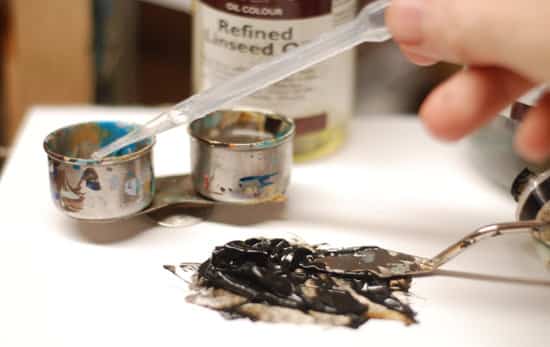
Paint consistency
When you are just beginning with oils, the handling of the paint can vary greatly depending on the consistency of the paint.
Oil paint (especially the titanium white) is often too thick and stiff to work with at this stage of the painting – straight from the tube.
To make the paint more fluid, I slightly dilute it with the medium shown above. I use a pipette to drop a few drops of the medium onto the paint mixture and mix it thoroughly with the palette knife. Using the palette knife for mixing your paints is a very useful technique.
The video below shows a quick tutorial on how I dilute the oil paint.
I often mix the colours on a separate, tear-off palette and then transfer the mixture to the clean glass/ perspex.
If you’re just beginning with oils you’ll notice how easily you can contaminate colours when using a full palette of colours, this can lead to muddy colours and frustrating painting.
This helps you to learn clean working methods. I am naturally more impatient so it is a discipline to spend the time mixing the colours as you just want to get painting but it will pay dividends.

Step 14 – Mixing our tonal colour strings
This next stage of the portrait is where we really get ‘painting’ as in, thicker, more opaque colours mixed together. If we look back at the last couple of weeks lessons you can see that we haven’t actually mixed any tones together yet.
We have simply been blocking in the basic tonal values, in what is sometimes called the ‘dead colouring stage’ this is because we are using a limited amount of oil in the mix, and more mineral spirits. As the mineral spirits evaporate the colour can appear flat, and ‘dead’ as it doesn’t have the lustre that the oil gives us.
Pro tip: When working with colour, this is also referred to as adding the ‘local colour’ of a subject. For example, a lemon would have a local colour of yellow.
So before we start the painting we are going to premix a range of 9 value tones.
White (1) is the lightest, black (9) is the darkest. This enables us to get a mid tone 5 and split the tones into lights, half tones, and darks. These are called tonal strings, you can read more about them on A beginners guide to tonal strings
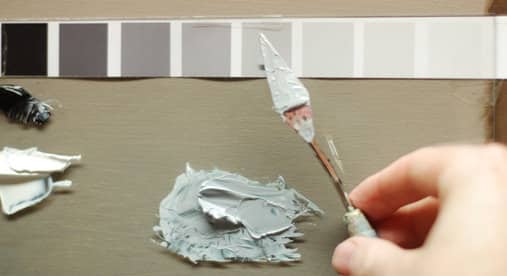
Using a value strip

Print out, or paint out, your own value strip.
When you are first starting, working from a print out it can be handy because the value strip will be the same tones as your reference photograph compared to the hues of the black and white paint if you were to paint your strip.
Just slide the value strip under the glass. This way when you are trying to match the tone you can test it by dabbing a swatch ontop of the tone underneath to determine how close you are.
The first tone I match is a number 5. It will take you a few attempts to get it spot on, this is normal.
Be aware that the black has a stronger tinting strength than the white so when I add it I’m just scraping a small amount with the palette knife.

I then match a light value 3
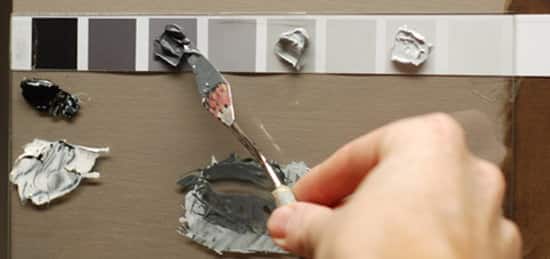
Then a value 7. With these 3 tones, you can create some great value studies (which are sometimes called ‘poster studies’) these allow to quickly practice and sketch out tonal compositions for future paintings.
It is also handy if you want to experiment working with a compressed value range.
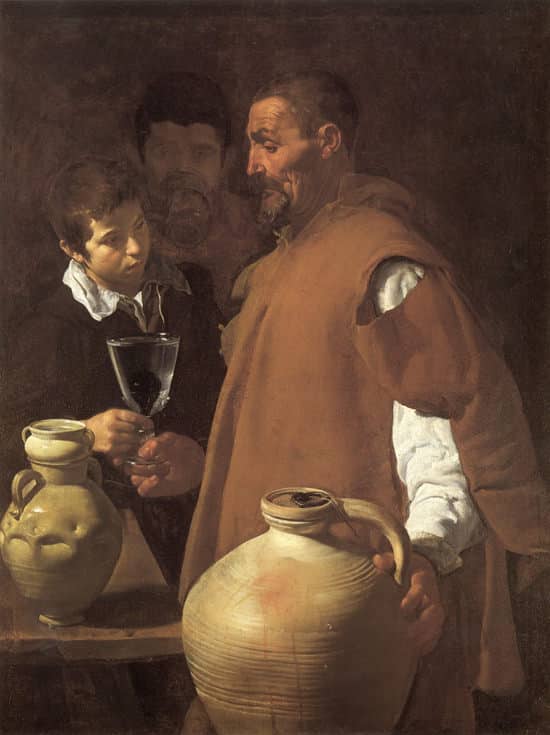
Waterseller of Seville –Diego Velazquez, 1619
If we look at Velasquez’s painting below we can see his use of the umber underpainting, and the range of tones used to direct the views gaze.
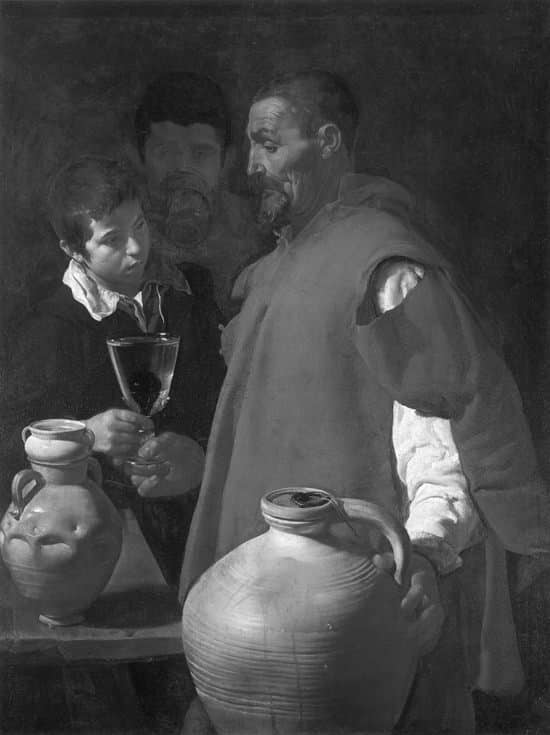
When we look at the painting in black and white it is even easier to see how the most focus on the painting has been placed on the subject with the broadest tonal range and the background figure has a very compressed tonal range.
9 value tones
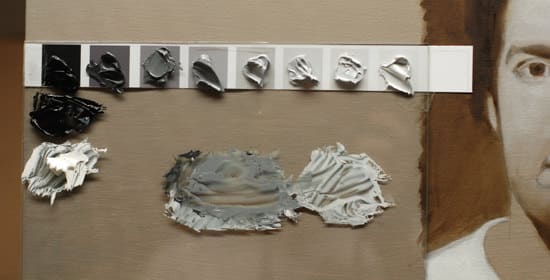
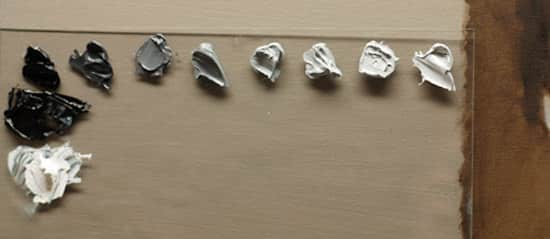
I then remove the value strip and we are ready to begin.
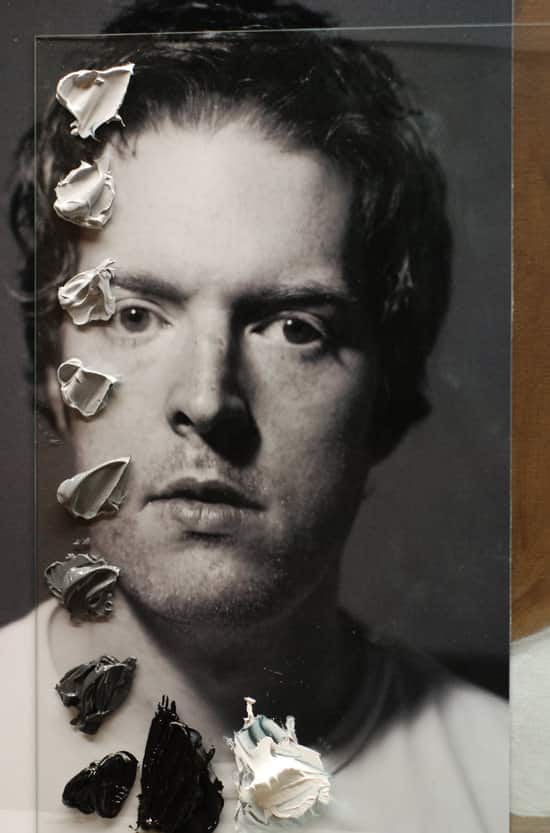
Due to my light source being above the subject the light drops off as we get further down the face. When you look at the colour strings you can start to see how there is a subtle shift in tone as we go down the painting. This is a key point to remember because when you take the paint swatches away it is harder to judge the light drop off, your mind just accepts it.
The light was set up so that it was stronger on the top half of the portrait, and the value drops away. You need to be aware of this drop off as you progress through the tones.
This can help in getting the fall of light right, and creating a logical progression throughout the painting.
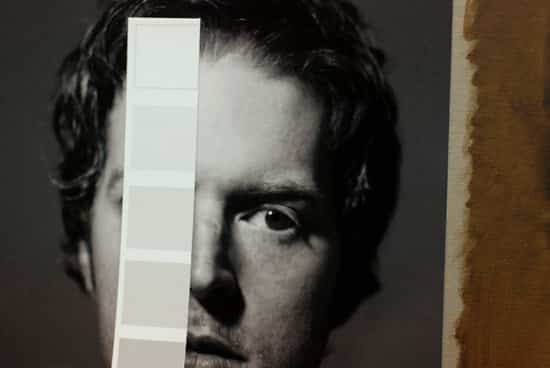
So what you can do now is remove the value strip from underneath the paint and hold it next to your reference photograph. Make sure you have trimmed the edge of the value strip so you don’t have any white on the edge. This will make it harder to judge tones.
Now shut one eye, this helps to flatten your vision and makes it easier to see tone. Then flick your eyes between the tone and the value strip and the tone on the reference photograph until you have a match.
Pro tip: If you are finding it hard to isolate the colour the use a hole-punch to punch a hole in each square, this way you can use them as a viewfinder.
Solid painting
“For purposes of study there is nothing better than simple, direct, solid painting. Painting with transparent colour, with a mixture of solid and transparent, glazing etc are all things that must be tried later on; but for some time confine yourself to direct, solid painting.” – Harold Speed
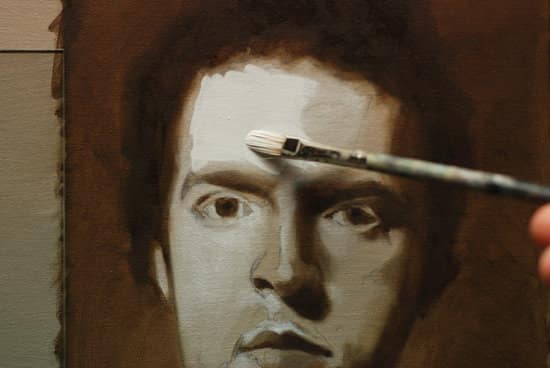
On my image I start with the lightest part on the forehead, it is about a value 2.
I dip just the edge of my brush (number# 4 Rosemary & co Ivory Filbert) into the medium.
I then pull the paint from the side of the mixture and coat the end of the brush. The mixture is thick enough to cover the underpainting, but still quite thin.
You are looking to cover the colour underneath with a solid tone but still have a fluid mixture. Getting the consistency right can be an art in itself, so don’t get discouraged!
We just want a small amount of paint, notice how I pull the paint from the edge of the pile.
You also don’t need much paint, just try to get the tip of the bristles coated, I work the brush back and forth in the paint so it has a coverage, yet doesn’t come up the bristles too far.
A beginners tendency is to overload your brush.

I then flick my eyes between the subject and my painting to judge the next tonal shift, I squeeze any excess paint into a piece of kitchen roll until the brush is dry,
I can then grab some of the next value down – value 3
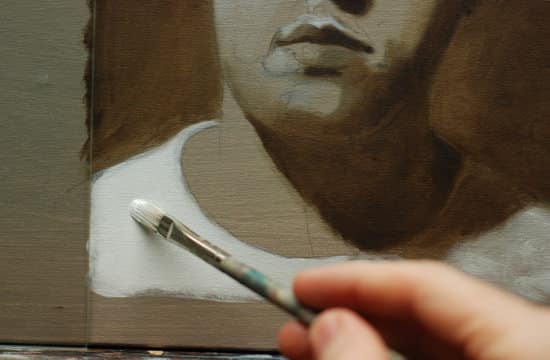
Just to help my eye with the portrait, I reinforce the white of the t-shirt with value 1.
This could have been put in first, there is no real hard and fast rule, I just scan the picture with my eyes to look for any values that are in the first 3 light range.
Adding the mid tones
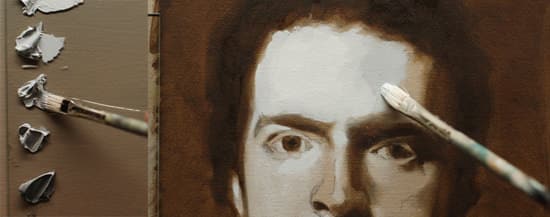
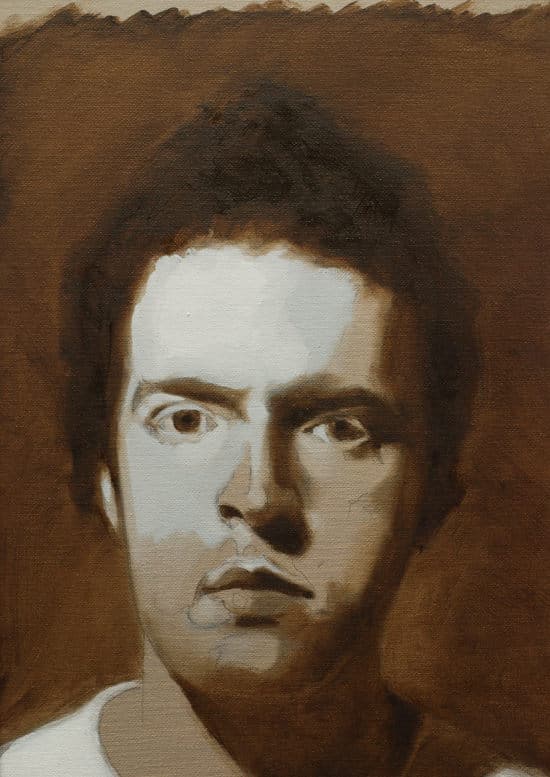
I then move on to the mid-tones, again with a clean brush (I might dip it into pure mineral spirits occasionally and scrub out the pigment into kitchen roll so I have a clean brush for the new tone.
I then make my way down the tones using 4, 5, 6. Notice how these are all still in the lights of the subject.
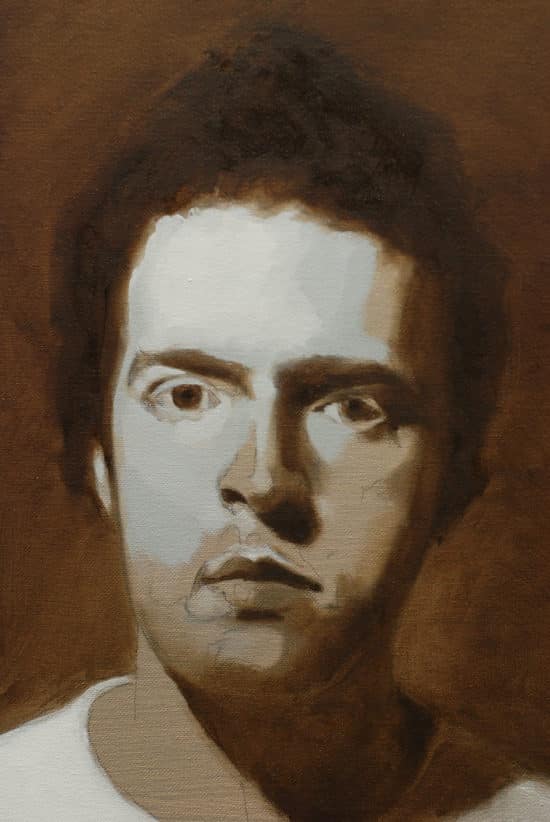
I haven’t blended any of the tones, I am just simply blocking them in with a flat tone.
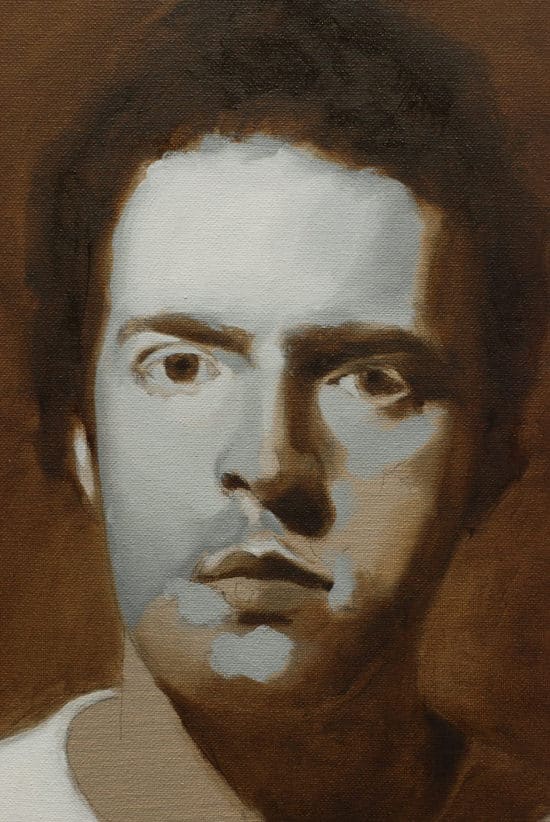
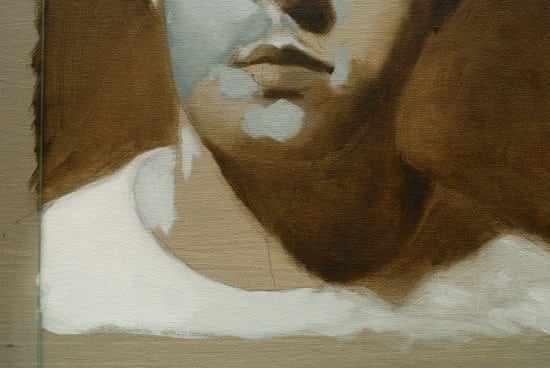
I then block in the tone on the neck, again this could have been done earlier but you’ll find the more tones you add, the easier they are to judge in comparison.
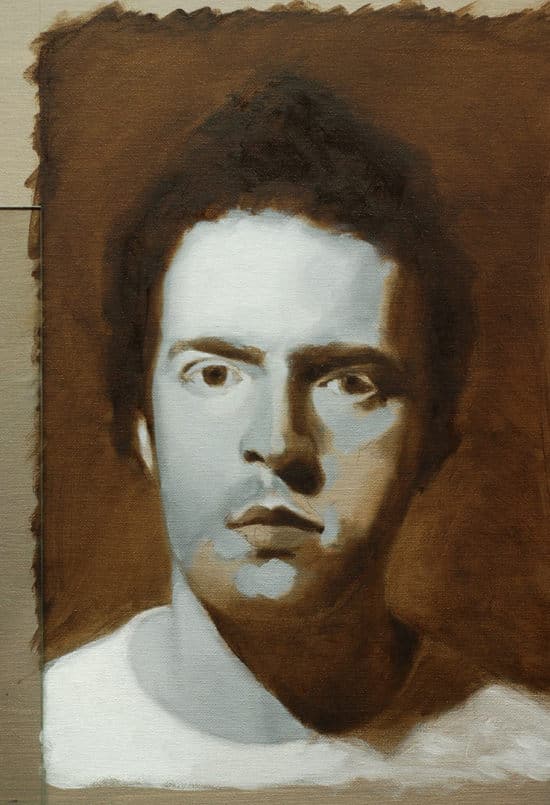
All of the lights are now added, this has all been painting with values 1 through to 6.
We are now going to add the darks, working through 7 to 9
Adding the darks
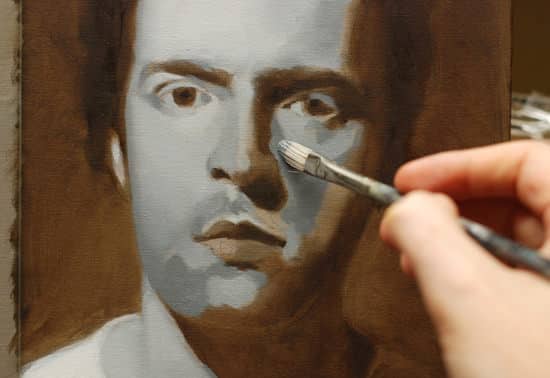
As the light starts to drop off, I add the darks into the shadow side of the face, notice how the tones have been dropping darker to the right and the bottom of the picture due to the light source being from the top left.
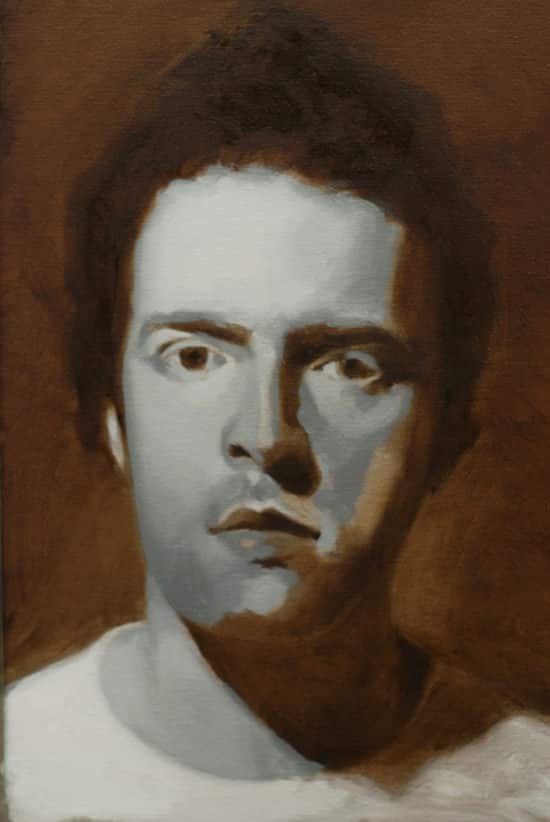
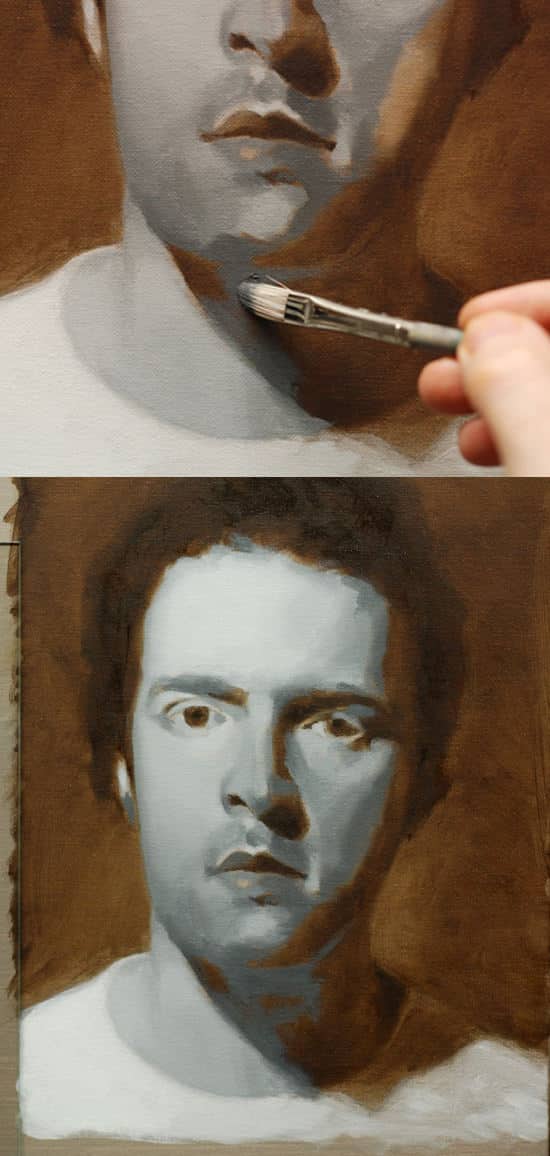
I continue adding a darker value 8 into the shadow under the chin. Notice how blue the paint appears next to the raw umber. The tones are still quite flat with limited blending, still just using the size 4 ivory filbert.
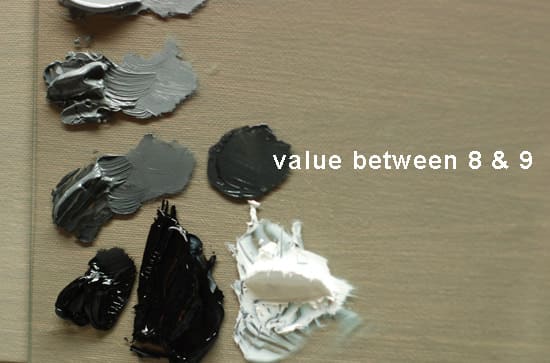
I now mix a value between the 8 & 9, you could go straight in with the 9, but I wanted to leave this for the final part of this stage.

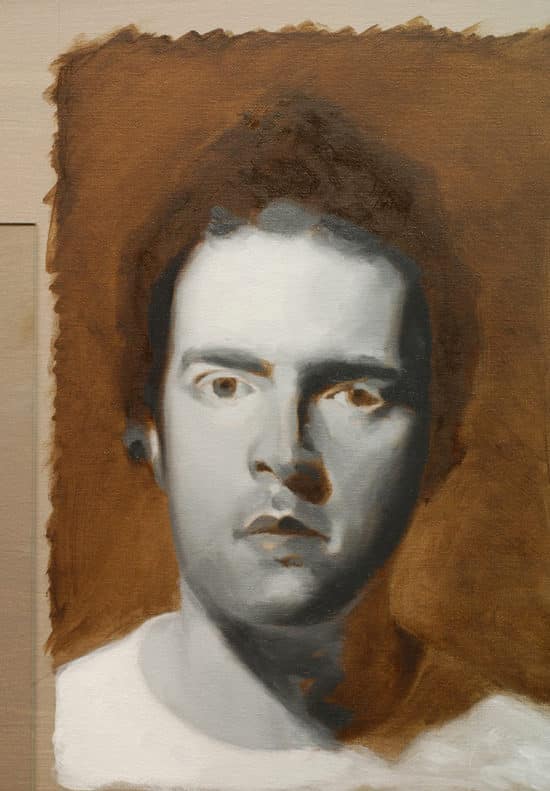
I then soften the edge slightly using the filbert.
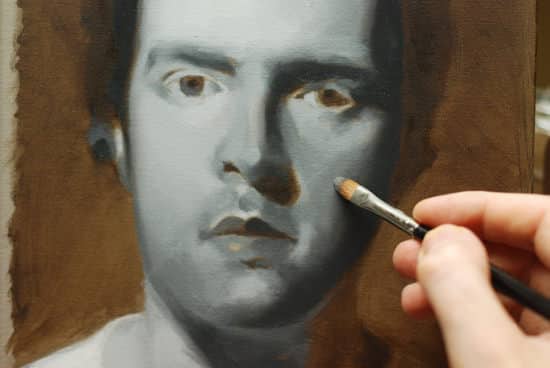
I swap to a sable filbert for blending the edges further, as I mentioned before, I often use the Ivory filbert for this, but sometimes, if the paint is pulling too much the sable can just give you that blend that you are after.
Because the underpainting is now dry I’m resting my little finger on the canvas, this way I can pivot, with a stronger support. For larger scale painting, or of the background is still damp I would use a mahl stick.
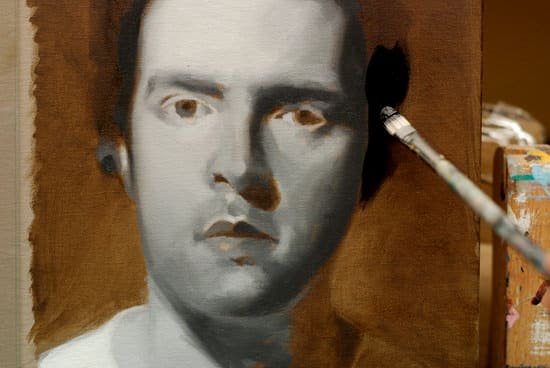
This is now with the value 9, the pure black mix we have made. When this first goes on it will feel too dark. It’s not.
I block in this black slightly thinner than the previous paint, I’m still concerned with creating a flat tonal value. Notice how I’ve left a slight edge between this darker tone and the edge of the face. This way when I soften the edge it won’t go too dark.
A tendency when you’re first starting is to add, then blend, add then blend, but it will work better if you keep the blending to a minimum.
This is easier said than done.
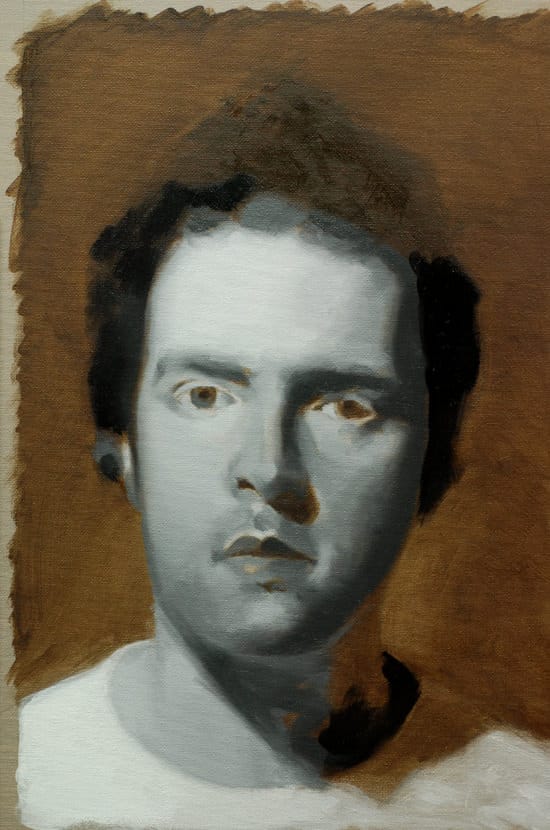
Notice how light the first shadow now looks in comparison to the black.
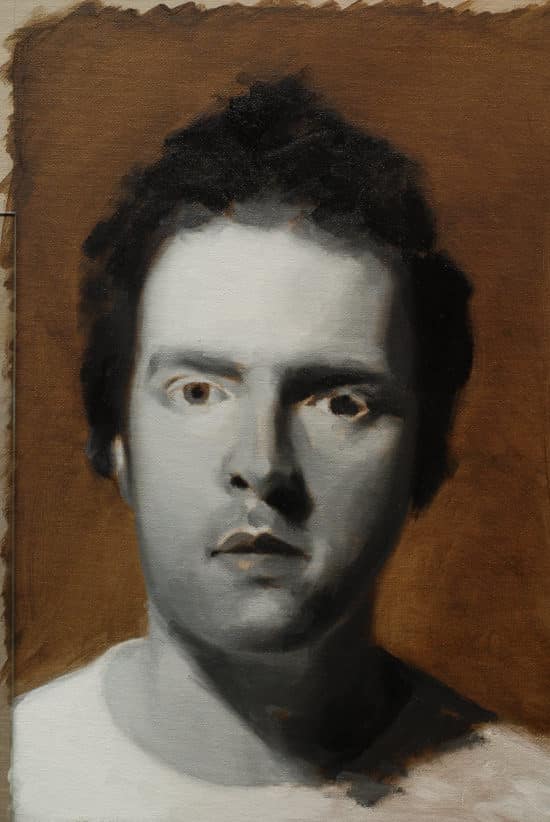
This stage of the painting I now have a full tonal range of opaque colour. I can now assess the reference image and flick my eyes between the two, looking for anything that looks ‘out’.
The Importance of edges
I now look to soften out most of the edges. As with the underpainting, it is easiest to keep the edges soft at this stage as they can easily grab a viewers attention. Sharp edges come forward, soft edges recede back.
Pro tip: If you are having trouble pulling the paint too much – swap to the larger size 10 filbert and gentle blush over the edge.
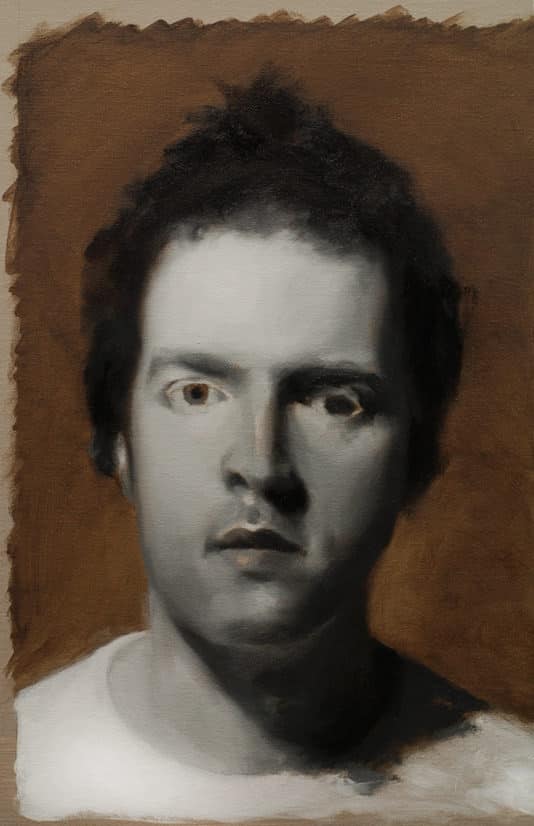
We’ve now finished the first stage of modelling the portrait. I haven’t worked on the features much, still just keeping the focus on the main areas of the form. The larger areas first, then we can add details in the next stage.
You might also like:
1. How to Paint a Portrait in Oil – Part 1
2. How to Paint a Portrait in Oil – Part 2
3. How to Paint a Portrait in Oil – Part 4
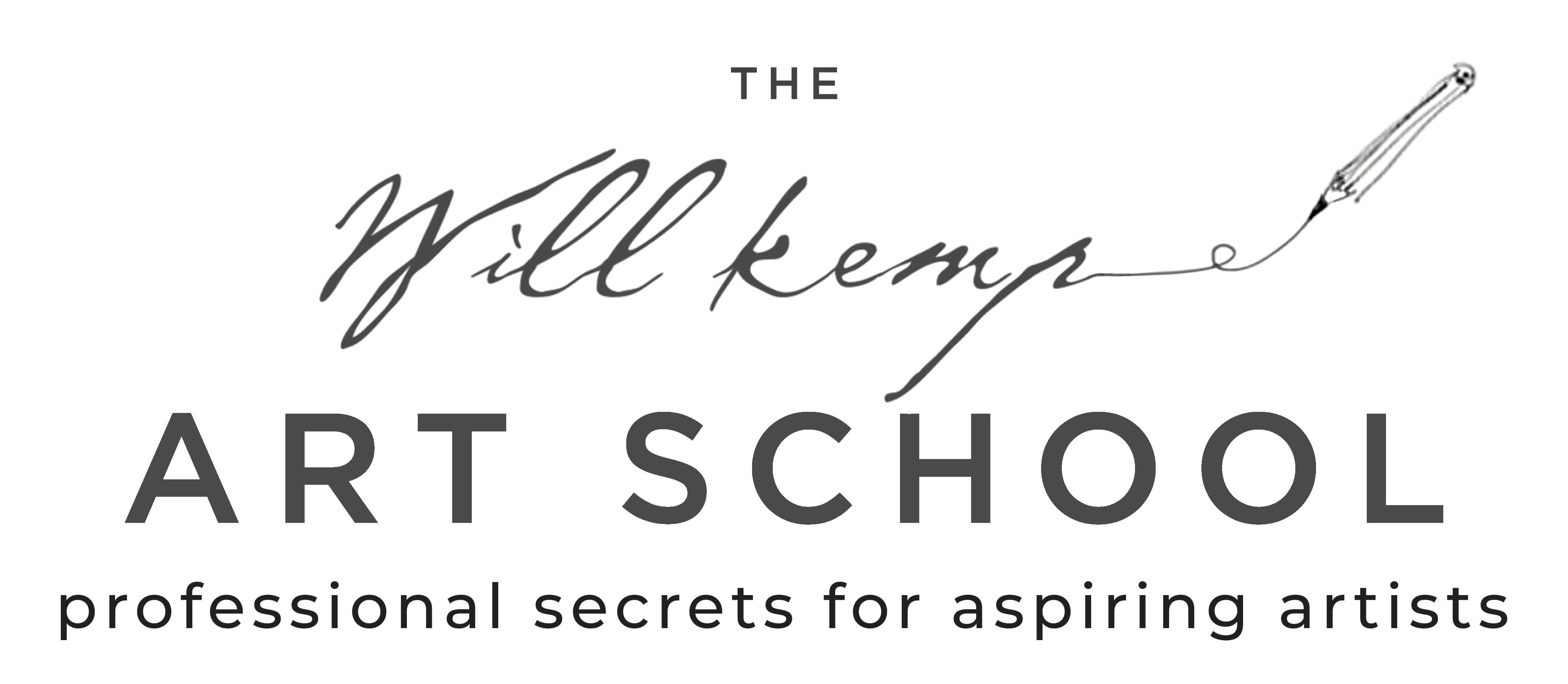
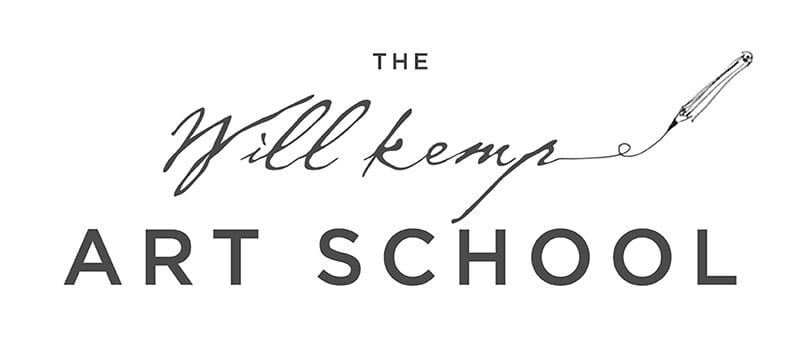
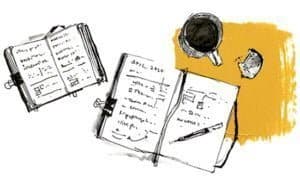

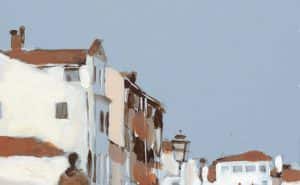
Hi Will,
I have a question about your image which shows the 9 tones of the grey colour string. Would it be possible for you to give these 9 tones in terms of RGB (or H, S & B) values on photoshop? This way I could make my own grey colour string swatch on the computer and print it out.
Also, as a beginner who has limited resources, is it worth using oil painting paper instead of canvas until I get the hang of the technique? Are there any issues with this type of surface that I should be aware of?
Loving your work,
Dave.
Hi Dave,
Glad you like the progress.
Yes, if you have access to Photoshop you can create your own value scale. Matthew Innis (from Underpaintings blog) talks through how he makes a scale using the Munsell system (this is another approach for mixing and matching colours and, confusingly, used 10 steps and the values are labelled the other way) using Photoshop – See below:
This, however, is for straight black and white, our mix is slightly warmer so might need a bit of tweaking.
If you, or any of the readers, have another way to make a value scale with photoshop please add to the comments.
Yes, by all means practice on oil painting paper, you might find it feels like it ‘sits’ on top of the surface more, but just use a thicker mix of paint.
Thanks,
Will
Hi Will,
I was wondering about brushes again, and would like to know what is the difference between a Bright, Flat and Shader. My local art store in Chicago does not have the brands you talked about. Only Princeton ( they artist there say that they are from the UK).
I would like to know if you think that if the painting/drawing is wrong if it does not represent the model perfectly.
David A.
Hey David,
The difference between them is shape, so all have different uses.
Flat:– Flat square edge.Good for broad strokes and creating straight lines. Not the ideal for portraits because we want soft edges.
Bright: Brights – The shorter, sturdier version of the flat brush, (so has less flex – if you were working with thick oil paints a bright would be able move the paint around easier.)
Shader: I think this is just a brand name and not in general used in other brush manufacturers. I had a look at the Princeton website and the Shader is very similar to a flat.
I forgot to mention Rosemary & co are mail order, but in terms of the Princeton brushes, tell me your budget and I can advise which ones would be best.
There is no such thing as perfect representation, capturing a models character is more important than a photo realist drawing. This all comes with practice and developing your own style as an artist.
Don’t get hung up on it being perfect, I’ve seen so many students start portraits get disheartened and not continue on, just out of interest Picasso produced 50,000 unique pieces of art over his lifetime.
Not every piece has to be a masterpiece, the process is just as important as the end result.
Thanks
Will
Hi Will,
My budget per month is $25-35. I use half for painting and half for drawing.
The Princeton brushes at Blick cost between $6.29-15.00.
David A.
Hi David,
You might be interested to look at the Winsor & Newton Artist Quality oil Brushes (available at blick) these are really excellent brushes and the ones I use if I’m not using the Rosemary & Co Ivory Filberts. They are slightly more reasonable than the Princeton brushes and I can feel confident in recommending them.
A couple of handy sizes (if your working quite small – A4 paper size) are:
Long Handle Filbert, Size #2 ($4.37)
Long Handle Filbert, Size #4 ($5.14) (this is the same size as the brush I use for 90% of this demo)
Size #5 & #6 are also handy.
Also, a small round for details with slightly softer hair, so either one of the synthetic sables from Princeton (series 4000) or Winsor & newton Monarch are nice. (between a size 0 and 3 depending on how detailed you work – I use a size 3 for this demo)
For blending the filbert princeton size 6 ($6.45) or 8 ($7.05) (series 4000) is closest to what I have used.
You could just start with the oil brushes though and see how you get on.
Hope this helps,
Will
Do you ever use a different mixture for your shadows such as mixing a red, ultramarine blue, and yellow ochre? This would be used after the initial raw umber stage on just the shadows. I am starting to learn to paint portraits and have been told using this mixture allows the shadows to remain transparent later on, however it seems to make things more complicated than your method. Thanks for this series; it’s very helpful. Looking forward to the next part…
Hi Michelle,
Pleased to hear you are enjoying this portrait painting series. As this techniques is focusing on the importance of tone and making the step from drawing to oil painting keeping it simple really is the way the to go. So I will be only be using the raw umber and Ivory black.
For full colour portraits, I use a similar, simple approach. And wouldn’t initially use red, ultramarine blue or yellow ochre. I would still use a earth pigment like raw umber or burnt umber.
Different artists have different approaches, but I am a great believer in keeping your materials simple, so you can have more time to concentrate on the tricky part, the painting.
Hope this helps,
Will
Hi Will…everything okay here! Have started playing with Golden liquids, [10 half oz. bottles for 40.00] and find them interesting! Must pick up a 40 series knife to do my mixing of the ‘heavy’, as the spatula type I have is awkward for me, but progress, as I also found paper pallets I used to use with oils. There is something about a clean WHITE mixing surface..that colorblind moi finds more accurate somehow in delineation of shades. Anyway, makes sense to me to me, and that’s just fine.
Many thanks for your patience. cheers…rod
Hey Rod, yes the fluid acrylics can be very effective, especially for glazing effects.
Cheers,
Will
Hello, I don’t really understand why you need to paint first with raw umber; why can’t you just paint with black/white straight onto the canvas? Sorry if that’s an obvious question.
Thanks – Alice
Hi Alice,
Thanks for the comment. The reason I paint onto a toned ground is because it makes it easier when you are first starting to judge your tones.
You can quickly establish your darkest darks and lightest lights and this will make it easier to judge the other tones in your painting. One of the biggest beginner mistakes is working onto a white canvas. you can read more about it here: How a prepared canvas can drastically improve your painting.
Hope this helps,
Will
Hello Will,
Enjoying working through these lessons so far. Your method produces a nice look to a portrait similar to Velázquez.
Regarding a value strip, I had a go creating one using GIMP (the free photo-editing software). I edited the brush colour and altered the HSV (hue, saturation, value) settings. Changing V amount from zero (black), 50 (mid-grey), 100 (white) etc. and all the tone gradations in between.
David
Hi David,
Pleased to hear the portrait course is going well, and that you could create a value strip using GIMP, good one!
Cheers,
Will
I am passionate about painting the figure, but have only worked in watercolors. My question. Do you think it best for me to begin to learn painting in oils or do you think I should work in Acrylics first. I was in fine arts for 10 years before I became an art therapist. Now that I am retired I want to focus on painting the figure…..portrait……. Can you help direct me to make the most of the next 10 years. My concern is the time it will take me to master two mediums (acrylic and then on to oils). I like your demo’s and think I can start with good training….But which training to begin with is my question.
Hi Bernice,
You might find this article helpful that goes through the differences between the two, many of my acrylic painting techniques stem from classical painting techniques, so you are inadvertently learning skills for both mediums.
Hope this helps,
Will
Yes, thank you. I think you are saying it would be good practice and learning in acrylics before starting oils, since most of your acrylic techniques are taken from classical oil techniques? Correct?
Hi Bernice, yes, I’ve found for learning about colour mixing and paint techniques acrylics are very forgiving because you can easily work over them, so are a great medium to learn with, can be painted anywhere, on pretty much any surface, so are like a quick start painting. Then, when you feel move confident in colour mixing and brush techniques you can go into oils there and will be less ‘mud’ mixed and more ‘a-ha’ moments, as many of the techniques I teach are transferable.
Cheers,
Will
thank you so much for your kindness and expertise. I believe you illustrated the best lesson on value that I have ever seen. Looking forward to happy days of painting.
You’re welcome Bernice, thanks for your kind words. Looking forward to seeing your results.
Cheers,
Will
Hi Will..
So for this layer when you add the white, (either for adding white on the t shirt or for the light areas or mixing to get the other shades of grey), are you using as per the mixture stated 1:3 – Linseed oil:OMS ?? In Stage 1, you have advised me to go with Flake White and little OMS. So, is it okay to add in the Linseed oil here and going forward?? the reason i am asking is i keep hearing of white giving out in the long run (getting yellower) and they blame the medium for it. I assumed it was the Linseed oil causing it to yellow. Your advice on this would be much appreciated.
Yes that’s right the same medium.
Cheers,
Will
Will, thank you for the response. But looks like I am a little confused here. Could you please help me.
“You’ve got 2 choices, if time isn’t an issue, mix your white as we did before in Part 1 with a little OMS, this way it will take a little bit longer to dry .” —
– I have followed this so far. So, from now on, be it the greys or white, shall I go ahead and make the medium fat (adding Linseed oil to the medium) or would you still advise me to go ONLY with the OMS for my Flake White? Please help me.
– Can I go ahead with my Flake white for steps 3 to 5?
Apologies for keeping you bothered.
Hi Archana, yes that’s right just add Linseed oil to the medium for mixing the greys.
Cheers,
Will
Thanks soooo much!!! :) for being extra patient and answering to our queries. You have been a great help!!!! many Thanks again!!!1
Hope the portraits coming on well Archana.
Cheers,
Will
Thank You Will! Happy New Year! Happy Painting!
I’ve been using a water based oil paint and walnut oil, no other medium. What’s your opinion?
Walnut oil can work well for a non-toxic oil painting.
Will
Hi Will,
Thanks for the information you have kindly shared, I’m finding it so helpful.
I just have a question about blending the tones when the paint has dried, do I just add some OMS or do I need to re paint the area that needs blending with more linseed oil in the mix (fat over lean) ?
Thanks again,
Nicola
Hi Nicola, pleased you’ve been enjoying the lessons, you won’t be able to blend the tones when the paint has dried, if you add OMS it can wipe back the paint but isn’t the best way to blend and the paint will drag and smear rather than blend, or not wipe back at all.
Hope this helps,
Cheers,
Will
Hi will just wondering what your thoughts were on using titanium buff instead of using titanium white in portraits .? Thanks
Hi Dan, it can work well if you’re looking for an overall warmer hue to the skin tones. You can mix your own with a touch of titanium white in Naples yellow to see if you like the colour.
Cheers,
Will
Cheers will
Hi WIll,
I am trying a portrait but I think I am spending too much time on the detail. The thing is, my photo has me smiling and therefore I show a lot of wrinkles and hence many different tones all over the picture, as well as the light and the dark. My questions is, as I am finding it hard to separate the tones because of the wrinkles, should I just block paint the tones and cover the wrinkles, adding the detail later, or continue to paint them in? I am worried that if I paint them over, I will not be able to add them in the right place afterwards.
Having said that, I am learning so much from this tutorial, especially about contrast, for which I am heartily thankful.
Louise
Hi Louise,
I would look for the big fall of light to start with and then add the details over the top, it can seem a case of painting out your drawing just to redraw it again, but the effect will be more convincing with the shape and forms of the face. Pleased you’ve been finding the lesson helpful.
Cheers,
Will
Hi Will,
Thanks for that. You are so right. I have so many “bits” on the painting with some still unpainted and it is hard to see the form. I will have to be courageous and paint over the wrinkles and add them later.
Louise
Hi Will, I know this is not exactly what the tutorial is for, but I am trying to paint a portrait in the style of Gerhard Richter’s blurred portraits, and I was wondering if you had any thoughts on how I should go about this? So far I’ve stuck to your tutorial and I was just going to blur the paint with a squeegee or something at the end of the process, but I realised that to get the effect I would need all the paint to be workable at once, and there would need to be a reasonably thick layer, so I would have to work a bit quicker and in less stages. Do you think thats right? cheers
Yes, that’s right you would need all of the surface to be wet at the same time, you wouldn’t necessarily need the warm burnt umber underpainting as many of his black and whites are quite cool and you wouldn’t need the final glazing stages, so if yoou work from the black and white tones you’d be able to achieve the effect with the squeegee, It depends on the level of blur you’re after but you can see some of Richters squeegee technique in this documentary.
Hope this helps,
Cheers,
Will
thanks so much for this! the documentary is so helpful
Hello,
Thank you for providing this wonderful service. Although I have been educated at the University of Florida College of Fine Arts with a focus in painting, I am always hungry for more knowledge. Your teaching method and skill are excellent. I am presently working on a portrait commission and have found your lessons to be very valuable.
That’s brilliant to hear Diane, so pleased you’ve been finding the portrait lesson valuable in your work. Hope the commission goes well.
Cheers,
Will
Hello,
In reading you mix of mineral spirits and linseed oil “medium for this stage being a simple mix of 1 part linseed oil to 4 parts mineral spirits”, or any other mix, what amount of paint are you adding it to? What size would the approximate blob of paint be?
I thank you in advance for any information.
Happy Holidays. :)
Hi Vincent, it’s harder to explain in text as it varies depending on the amount of coverage (less medium) of fluidity (more medium) that I’m trying to create with the brushstroke.
Cheers,
Will
Hello again Will,
What I’m trying to understand are the approximate ratios of mediums vs. paint. When using say, “one mix” of medium, does it really matter how much you add to the paint blob? My understanding is that using more of that “one mix” medium will make the paint mix more fluid, transparent and “FAT”if I’m correct? Also when using the “one mix” medium, I assume the dry time would be longer due to the increased amount of the “one mix” medium vs. paint?
I hope that all is well and look forward to receiving your reply when you have the opportunity.
God Bless and Happy Holidays :),
Vincent
Hi Vincent, it’s hard to explain the exact fluidity in text, but there is a full video course of the tutorial which shows the entire technique in video form. If the medium has a high percentage of OMS the drying will be quicker, if there is a higher percentage of oil the drying will be slower. Have a great time over the festive season!
Will
nice paintings
Thanks
Love this! I have a question. When doing any part of the underpainting, I see how you are blocking in various parts of the face with shades, do you let each of them dry before going onto the next? For example, from doing 1 to 2 to 3 to 4 in the black and white tones, do you wait for each to dry or do you block in 1 then 2 straight away and so on? Then, how do you know when to blend everything together? I think I have that problem. I can get the blocking in, but then I end up blending everything together too quickly I think and it just doesn’t end up working out…
Hi Spencer, I tend to block in first, then judge the forms, then blend as needed.
Cheers,
Will
This is So Helpful….Gold!! Thankyou so much
Glad it helped Nick
Hello again Will! I’m midway through my 4th attempt at following your excellent instruction. It’s amazing how in each attempt I feel like I’m reading certain instructions for the first time – like they just appeared! Another question for you to provide some clarity – You have left some areas with the underpainting showing. Are these areas highlights to add in the final stage – or are they simply too much detail at this point in the process, and you want to keep within the basic shapes for now? Or some other reason altogether? Thanks again, and hope you’re having a great weekend. SJ :)
Hi Sarah, yes, these are areas that will often be highlights or similar in tone to the ground colour.
Will
Hi! Thanks so much for your explanations!
I’m always wondering…
Do you wait until the raw umber is dry before moving to the next step?(the whites and the blacks)
And if I had to add colors would you wait for the underlayer to dry?
I find it difficult if it’s wet, to apply the next color without it being too wet.
I kind of take the bottom color away instead of adding. Or is it all about your ability to have the right dryness/amount of color on your brush? thanks so much!!
Hi Greta,
Yes, wait until the Raw Umber is dry before adding the black and white. And then wait for black and white to dry if adding colour.
Cheers,
Will